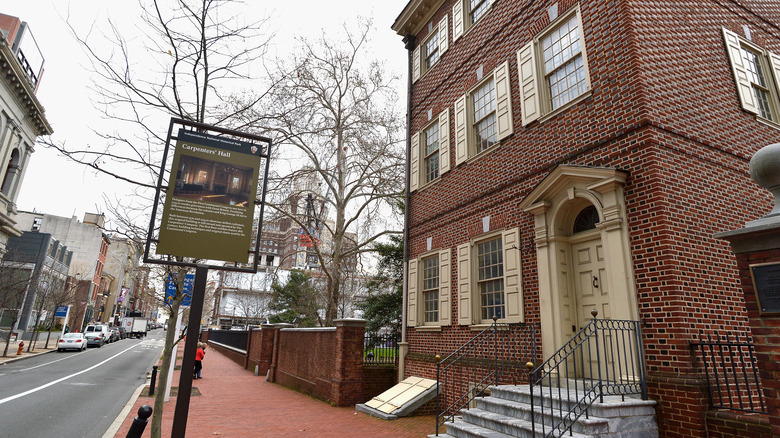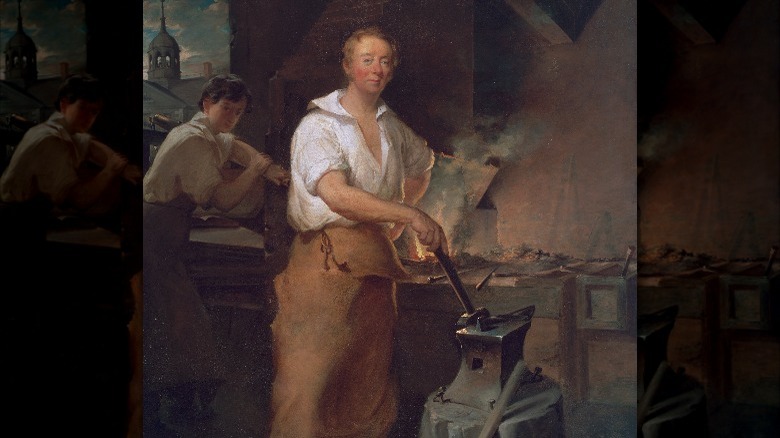A Foolish Decision Made By America's First Bank Robber Led To His Confession
Few buildings anywhere in America have a history that can rival that of Philadelphia's Carpenters' Hall. According to the building's website, it can trace its history back to the founding of the Carpenters' Company of the City and County of Philadelphia. In 1768, a lot was purchased along Chestnut Street in Philadelphia, and two years later, work began on what would eventually become Carpenters' Hall.
One of Carpenters' Hall's biggest claims to fame is that it was the site of the First Continental Congress. This meeting of representatives from each of the colonies was called in response to the Coercive Acts, which were measures taken by the British when colonists fought back against newly imposed taxes (via History). The building played an important role in the American Revolution and was at one point occupied by the British. After the war, businesses continued to move in and out of Carpenters' Hall. In 1798, one of the businesses moved in as the Bank of Pennsylvania, which was soon to be struck by the first bank robbery in American history.
The Bank of Pennsylvania moves into Carpenters' Hall
The Bank of Pennsylvania was preparing to move into Carpenters' Hall, but first, some work needed to be done so that the building met their needs. One of the jobs things that needed attention was upgrades to the vault doors, and to handle this, the bank enlisted the help of a local blacksmith named Pat Lyon. According to Carpenters' Hall, Lyon hailed from England and started studying his trade at just 11 years old. By 25, he was ready to cross the Atlantic and set up shop in the English colonies.
Lyon was working on the vault doors in his shop one day when Samuel Robinson dropped by with a stranger Lyon didn't recognize. Robinson was a carpenter and had been brought on to oversee the Bank of Pennsylvania into the building, so his appearance at the shop wouldn't have been seen as unusual at the time. The stranger also seemed to take interest in the vault's door locks and keyholes, but this wouldn't strike Lyon as odd until much later. Sometime later, Lyon was walking around the city with his apprentice when he came across Robinson and the stranger having a drink. The two seemed surprised to see Lyon and their reaction didn't sit right with him. "I don't think they are after any good," he told his apprentice.
Lyon travels to Delaware
In 1798, Philadelphia was in the midst of a city-wide bout with yellow fever. According to PBS, it was just one of three outbreaks that struck some of the nation's other major cities, including New York City and Boston, which left 5,000 people dead. Lyon's blacksmith apprentice came down with yellow fever, and in a bid to get him help, Lyon dragged him aboard a ship and headed toward Lewistown, Delaware (a town now known as Lewes). Unfortunately, Lyon's apprentice didn't survive the sickness, but Lyon decided to stay in Lewes for a little.
While he was there, he started seeing news stories about a robbery at Carpenters' Hall. The papers reported that $162,821 had been stolen from the Bank of Pennsylvania vault. Lyon was intrigued, given his connection to the bank. He was convinced that the robbery must have been an inside job, and his suspicions pointed to Samuel Robinson and the stranger who visited his shop (via Carpenters' Hall). What Lyon didn't know until he spoke with his old landlord, who was also in Lewistown, that the police also thought it was an inside job, only they thought he was the one responsible for the heist.
Lyon behind bars
Lyon's trip to Lewistown came at the wrong time and it cast suspicion on him almost immediately. According to Carpenters' Hall, upon hearing that authorities were scouring through the New Jersey woods searching for him, he hastily traveled back to Philadelphia, hoping to set things straight. That's not at what happened, and the Lyon was thrown in jail, accused of robbing the Bank of Pennsylvania.
The blacksmith would've been a decent suspect, given his role in fixing up the vault doors. Authorities suspected he had made an additional key to let himself in and make off with the money. Of course, Lyon was out of town when the robbery occurred, but they still thought he was involved. While there was little upside to being trapped in prison — especially since Lyon later wrote about how he feared for his life as deadly yellow fever tore through the prison population — he wouldn't be in there forever, because the real thief was about to make a giant mistake.
The first bank robber makes a rookie mistake
The stranger who visited Lyon's shop was a man named Isaac Davis, who worked for The Carpenters' Company, the one responsible for the Carpenters' Hall, the then-soon-to-be home of the Bank of Pennsylvania. Davis was the man responsible for the heist along with an accomplice who was never identified because he fell victim to yellow fever shortly after the crime. They also had assistance from the bank's porter, Thomas Cunningham.
According to Carpenters' Hall, with Lyon locked away and accused of being the culprit, Davis was sure that he was going to get away with pulling off America's first bank robbery, until he made a gaffe that is so painfully obvious that the vast majority of people would never, ever make it. Davis took the money he had stolen and deposited it in banks around the city — including the Bank of Pennsylvania. There were not two Banks of Pennsylvania; it was the same one he had stolen from. Bank officials quickly caught on that Davis had suddenly become extremely wealthy, and he folded like a cheap card table, admitting to the crime.
Davis confessed and agreed to return the money, and received a pardon from the Governor of Pennsylvania on those conditions. So, with the crime now solved, Pat Lyon was free to saunter out of the prison, right? Not quite.
Lyon finally goes free
Perhaps not wanting to wind up with egg on their face after locking up an innocent man, the authorities were adamant that Lyon was still guilty of making another key to the vault door. They held him in prison for weeks after Davis' confession. Upon his release, Lyon did what many falsely imprisoned people do even to this day: He wrote a book with what remains an almost unbelievably long title: "Narrative of Patrick Lyon Who Suffered Three Months Severe Imprisonment in Philadelphia Gaol on Merely a Vague Suspicion of Being Concerned in a Robbery of the Bank of Pennsylvania With his Remarks Thereon." It gave some insight into his life story and his tale of being held on the trumped-up robbery charges (via Carpenters' Hall).
The book caught the attention of lawyers who helped Lyon press a case against the bank and law enforcement officials, which he won, and was awarded $12,000. The whole ordeal made Pat Lyon something of a local hero, and he was immortalized in the painting "Pat Lyon at the Forge" (above) which was painted by John Neagle between 1826 and 1827 (via Pennsylvania Academy of the Fine Arts).





